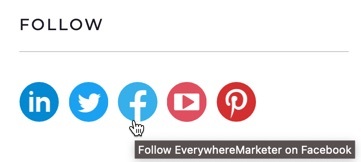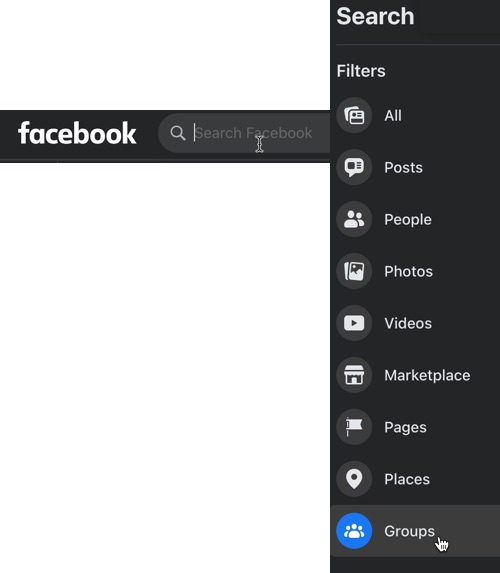With over 3 billion active users, Facebook is a powerful tool for promoting your blog by:
- Increasing your blog's visibility
- Attracting a wider audience
- Driving traffic to your content.
However, you need the right approach in order to maximize the impact of your activities.
In this post, you’ll discover:
- How to promote your blog on Facebook effectively
- Seven essential steps to help you:
- Build a strong presence on the platform
- Engage with your target audience
- Achieve your goals for your blog
Let's start by finding out how to optimize your Facebook page...
7 Steps to Promote Your Blog on Facebook
1. Optimize Your Facebook Page
First things first.
If you don’t yet have a Facebook Page, it’s time to create one! Find out exactly how via this previous post.
Already got one?
Then make sure it’s optimized in order to build trust, grow followers and give people confidence in visiting your blog.
That doesn’t mean your Facebook Page needs to reflect your blog.
Generally, your Facebook Page will reflect your brand, of which your blog is one channel (potentially feeding many others) that helps spread the word and attract customers.

But it needs to:
- Signal what you do, so that it resonates with your target market…
- Look professional, with good quality graphics and a properly filled-out profile that’s easy to read and is free of spelling mistakes and grammatical errors…
- Relay some measure of social proof, such as relevant accolades (like industry-related badges), your follower count (here’s how to grow it, also covered more briefly below), logos of authority sites on which you’ve been mentioned or published, and engagement with your community…
- Have a regularly-updated feed, which we’ll get into next!
And don’t forget to make it easy for visitors to your blog to follow you on your Facebook Page so that:
- You can continue to communicate with them…
- They can get to know you in different ways (after all, multiple touchpoints help grow sales).

2. Post Content Regularly and Consistently
Your Facebook Page needs to look active and alive.
That means posting content regularly, preferably via a systematized workflow that ensures much of it’s taken care of for you.
Otherwise, if someone visits your Page and sees the last post was published a few weeks or even months ago, their first question is going to be… are they still in business?
And at the very least, it gives the impression that no one’s there, and you may even give the impression that your business is untrustworthy, unreliable and not to be taken seriously.
Once you’re posting content regularly, make sure you do so with the right goals in mind.
Here’s something that confuses many: your main goal is not to drive traffic!
Woah! What?
You’ll see many people trying to promote their blog by constantly posting links back to their content.
The problem is, it doesn’t work (at least, organically).
While posts like that are fine in the feed every now and then, the fact is that organic posts linking to external websites generally sink.
After all, Facebook doesn’t want to direct traffic elsewhere, it wants to keep people on the platform because that’s how they generate revenue.

If you want to drive traffic, you need to pay Facebook to achieve the kind of reach you’re looking for (more on using Facebook ads in #5 below).
Instead, the main purpose of your organically-published posts is to:
- Keep your Page looking active and interesting (so that, for example, it doesn’t put potential customers off from purchasing from you)…
- Help grow your audience by giving people in your target market a reason to follow you…
- Attract engagement to help build social proof and spread your message…
This all helps promote your blog indirectly, with the most important being your audience.
Over time, that translates into:
- An enhanced reputation and increased visibility for your blog…
- More opportunities to collaborate with others, including those with significantly-sized audiences…
- People simply looking up your blog content, signing up to your list, connecting with you on other channels, and so on.
So what sort of content should you post?
The good news is that your regularly-published blog posts can translate into a wide variety of different types of content that can be posted to your Facebook Page. Here’s a quick overview, or click here for the full guide:
With those types of posts as your foundation, you can then add in other types of content such as company or industry news, product launches, behind-the-scenes type posts, and so on.
And in case you’re worried about posting too frequently… don’t be.
3. Grow Your Facebook Community
We’ve already said that one of the main reasons for regularly publishing content to your Facebook Page is to help grow your audience.
Your audience is effectively a community that forms around your business within Facebook—people who follow you because they’re interested in what you have to say.
As your community grows, so will your visibility on the platform, the opportunities that come your way, and the promotional value for your blog.
So, other than posting regularly, what are some of the ways you can attract followers?
To help promote your blog on Facebook, focus on growing your community on the platform. This increases social proof, attracts opportunities and builds visibility.Click To Post OnHere are a few:
- Run Facebook ads: it’s unlikely that using ads solely to grow your audience will prove cost effective, but you’ll find that running ads for other purposes (such as for driving traffic to your website) will attract additional followers anyway…
- Use your thank you pages: when people opt in to your list or purchase from you, use the thank you page to invite them to follow you on Facebook. Give them a reason to do so (such for Facebook-only promotions or for increased levels of support)...
- Add links to your blog: a bit of a no-brainer, but make sure people enjoying your blog content are easily able to find your Facebook Page and connect with you…
- Add links to your emails: in emails such as a regular newsletter, invite subscribers to follow you on Facebook.
- Participate in relevant conversations: join in discussions and engage with posts that attract your target market. Add comments that are thoughtful and engaging.
Foster the growth of your audience by encouraging them to interact with your posts, helping your content to reach other audiences and stimulating further engagement from others.
Some ways to do this include:
- Asking questions…
- Publishing posts that stimulate discussion…
- Posting video content…
- Running polls, contests and giveaways.
Make sure that when people do engage with you and leave comments or message you directly, they’re not hit by a wall of silence. Respond promptly to encourage further engagement in future, and help your community feel alive.
4. Take Advantage of Facebook Groups
Facebook Groups are a great way to access and communicate with communities of people interested in topics related to your niche.
Start by searching for groups with topics that relate to your blog and the interests of your target market. To do so, use Facebook’s search facility, and then filter on Groups.

Take some time to look through the different groups.
Avoid groups where there’s no engagement but lots of people posting content. Instead, look for groups where members are actually engaging with posts and with each other.
Note that:
- Some groups don’t allow Facebook Pages to join, only personal profiles… however, that can be more effective anyway because people prefer interacting with other humans rather than anonymous entities…

- Some groups are private, meaning the content is hidden until you join—try joining to check out suitability.
Look for a handful of more active and vibrant groups that look like they serve your target market and that you could add value to on a regular basis.
Make sure you read the group’s rules and guidelines before posting anything, and become familiar with the types of content that others post so you know what the general culture is.
Avoid just dropping links back to your blog and disappearing. Instead, consider how you can add genuine value by:
- Contributing to discussions…
- Offering helpful insights…
- Providing valuable information.
Engage with other posts in this way for a while before you start posting your own, so that people become familiar with you and the type of value you bring.
Facebook Groups can be a useful tool for promoting your blog. But don't just drop links and disappear. Contribute genuine value.Click To Post OnWhen you do start posting content, don’t make it all about self-promotion. Use your blog post to create value for the group, even if people don’t visit your blog. Link back to a particular blog post so people can get more info if they want—but don’t make this the primary purpose.
See the video in #2 above for the types of content you can create by repurposing blog posts, and use them here too.
People who are interested in the type of content you share will naturally seek out your Page and your blog.
You might even consider creating your own Facebook Group to build your own community around, and give you more freedom and options to promote your blog within it.
5. Use Facebook Advertising
As already stated, promoting your blog on Facebook via organic means will only get you so far.
To ramp things up significantly, consider using Facebook ads, through which you can target the kind of people you want to reach based on specific demographics, interests, and behaviors.
You can even use Facebook’s pixel, installed on your blog, to target people who are similar to those who have already visited your blog, perhaps even those who have opted in to your email list.
However, before you start using Facebook ads for promoting your blog, think about the specific objectives you actually want to achieve.
You may just want to send traffic to your blog, selecting the Traffic objective accordingly. But you may struggle to see a return on your investment, unless it’s part of a broader strategy, such as to then retarget those visitors with conversion-related ads.
Otherwise, it’s likely to prove more effective to focus on the Leads objective, with ads that offer a lead magnet related to your blog (perhaps even repurposed from a blog post).

Once on your list, you can then bring them back to your blog repeatedly (such as via a regular newsletter), building the relationship with them over time and generating revenue, providing the ROI for your ad spend.
Watch the following video for a quick overview of how to start using Facebook ads, or click here for the full guide:
6. Collaborate With Others
Naturally, there are likely businesses and influencers on Facebook serving a similar niche to your own, but with a (potentially significantly) larger audience.
Try finding users talking about similar topics via tools like BrandWatch or BuzzSumo. Make a list of several of them—ideally, a few dozen, if not more—and start reaching out to see if they’re interested in collaborating with you.
As a first step, think about the value you can offer to them, while requiring minimal effort from them. Remember, they don’t know you yet and likely get several requests a day from people they don’t know trying to get something from them. Instead, what can you give.
This might be the offer of a guest post on your blog, where you get an existing post of theirs expertly rewritten in their own style (but giving them full editorial approval) and published on your blog, attributed and linked back to them.
That’s a win for them, with no effort on their part, and they may be willing to reciprocate by sharing it with their social networks. The traffic attracted as a result can be used for example to create a lookalike audience in Facebook ads, or to advertise to such visitors directly via retargeting.
To help promote your blog on Facebook, collaborate with others who serve the same niche but have bigger audiences. Build relationships where they win too.Click To Post OnOther potential benefits for them might include:
- A free product or service…
- Shout outs on your social media channel…
- Other exposure on your blog, such as a review of their product or service, participation in a roundup post (where you’ve perhaps pre-written a potential contribution from them, closely based on other content they’ve created—remember, zero effort from them to get a win is ideal!)
However you decide to approach it:
- Make your message to them as personalized as possible…
- Make it clear what’s in it for them… don’t expect them to want to take time out of their day to help you, but with little direct benefit for them…
- If your blog has built up a large following or you have a significant social media presence, even if it’s not on Facebook, don’t forget to mention it…
- Follow up with them repeatedly and via different channels—relying on a single email with zero follow up won’t get you very far.
Once you’ve got their interest and potential agreement, be as professional as possible—do exactly what you said you would, make it as streamlined and as easy as possible, and over-deliver if you can.
They’re likely to want to reciprocate in some way, perhaps by sharing something from you on social media, giving you a shout out, or simply by being open to closer collaboration in future.
But don’t rush it. Take baby steps and remember relationships and trust take time to build. Keep giving where you can, and you’ll find at some point it comes back to you in spades.
7. Track Your Results
Of course, you need to know how effective your activities are in promoting your blog on Facebook. That means measuring and tracking your results!
One way is via in-built tools such as Facebook Insights, which provides data such as on:
- Reach — the number of people who see your content…
- Engagement — how people interact with your content, such as by liking or sharing it, or by leaving a comment…
- Conversions — such as signing up to your list or buying something.
Numerous other Facebook analytics tools are also available that provide you with more in-depth insights and can track data over longer periods of time.
Start by deciding which metrics you want to monitor, and use them to see what’s working and what’s not, which helps guide your future strategy.
For example, if you’re getting lots of reach but the actual engagement is fairly low, try changing the type of post you’re sharing, adjusting the copy used, and so on, seeing what effect such changes are having.
Test different approaches, such as different types of content, different ad formats, and different targeting options, and aim for continual improvements.
Even a series of small, incremental improvements over time can start to add up to something much more significant.

It’s important to:
- Have realistic expectations: significant results take time to build, often years. Don’t expect to see overnight success, your overall trajectory is far more important…
- Monitor the data: track your results and monitor your progress over time so you can see whether your efforts are paying off…
- Be patient: it’s easy to feel disheartened if not much seems to be happening. Keep going anyway. Avoid comparing stats on a week to week basis, as the fluctuations can be significant. Instead, compare this quarter to the previous quarter, or this year to last year, it’s likely to be a lot more meaningful (and motivating).
Frequently Asked Questions
How can I optimize my Facebook Page to promote my blog effectively?
Signal what you do, look professional, relay social proof, and have a regularly updated feed.
Why is it important to post content regularly and consistently on my Facebook Page?
Regular posting keeps your page active, engages your audience, and helps build social proof over time.
What is the benefit of growing my Facebook community to promote my blog?
Growing your community increases social proof, attracts opportunities, and boosts visibility for your blog.
How can I effectively use Facebook Groups to promote my blog?
Join active groups related to your niche, contribute value, engage with the community, and avoid excessive self-promotion.
Why should I consider using Facebook advertising to promote my blog?
Facebook ads help target specific audiences, expand reach beyond organic efforts, and drive traffic effectively.
To Conclude
Promoting your blog effectively on Facebook requires a strategic and often multi-pronged approach for maximizing reach and engagement, as well as a fair amount of patient regular and consistent action.
The seven steps outlined in this post effectively give you a roadmap for doing just that. But remember that achieving results takes time.
The most important factors are consistent effort, monitoring of your metrics, and continuous testing to discover what works best for your audience and what you can further improve upon.



